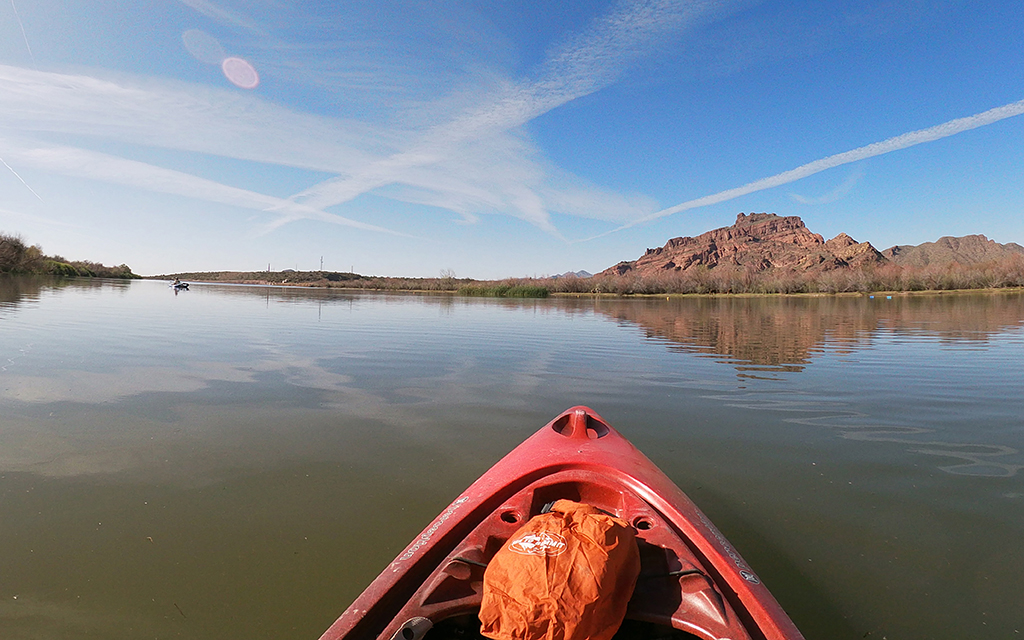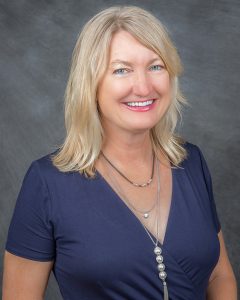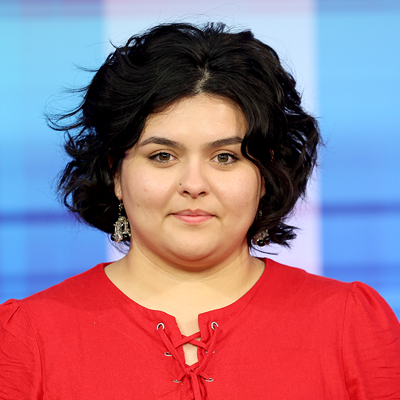
The Salt River is popular for water recreation, including this spot near Granite Reef, pictured on Feb. 24, 2023. (Photo by Izabella Hernandez/Cronkite News)
PHOENIX — Environmental activist Lynda Person is inviting the public to bring kayaks and water toys to an informational event called “Where’s the River?” near 40th Street and University Drive on Tuesday.
Spoiler alert: There won’t be much kayaking on this largely dried-up portion of the Salt River south of Phoenix Sky Harbor International Airport and west of the dam that creates Tempe Town Lake.
Person, event director for Sustainable Water Network, is hoping people will see firsthand what’s happening to Arizona’s depleting waterways, just as the state is having to grapple with water shortages and negotiate with neighboring states that utilize the Colorado River.
“People don’t even remember there was a river (here),” said Person, who promises guest speakers and a scavenger hunt at the free event from 3-6 p.m. Tuesday, March 14, at 2425 S. 40th St. in Phoenix.
Person chose this patchy part of the Salt River to show healthy rivers should flow year round. Salt River Project announced for the first time since 2019 it is releasing water from Bartlett Dam on the Verde River this month that will flow into the Salt River, causing some low-level flooding in the east Valley. However, Person said this rare water release won’t save the river in the long run.
Sustainable Water Network, formally the Sustainable Water Workgroup, focuses on protecting Arizona’s bodies of water through conservation, restoration and evaluation. Kristen Wolfe, the Sustainable Water Network coordinator, said this event is important to “draw attention to the lack of protection for our rivers.”
River flows have been hit by a combination of factors, including the ongoing drought, surface and groundwater use, and dams and reservoirs that restrict flow. However, the management of groundwater and surface water is a key reason why Arizona is seeing less water than before, event organizers said.
Since 1919, Arizona has had the Arizona Surface Water Code — now the Public Water Code — that allows any person, the state or political subdivision to take unclaimed water for “personal use or for delivery to consumers.”
This applies to Arizona’s six main rivers — Colorado, Gila, Santa Cruz, San Pedro, Salt and Verde — that Gary Beverly, from the Citizens Water Advisory Group, will talk about at the event.
“Water is life,” Beverly said. “Without water, you don’t have food. Without water, you don’t have public health — and so, everybody knows they need it. And right now, everybody is competing to get as much as they can get.”

Lynda Person is the Sustainable Water Network event director. (Photo by Rebecca Bloom Chapman)
Outside of six Active Management Areas recognized under the Arizona Groundwater Act, Wolfe said there are few rules and regulations about pumping.
“Over the last few decades, a lot of the development now has moved into these more rural areas,” Wolfe added.
Groundwater that doesn’t fall under the Active Management Areas is used mostly by farmers for crops, Beverly said, adding the water irrigates mostly low-value, high-water-use crops, such as alfalfa and cotton.
“We live in a dry region of the country. We should act like it,” said Sandy Bahr, the Sierra Club’s Grand Canyon Chapter director, who works with state legislators and will be at Tuesday’s event. Bahr said good water conservation legislation is needed, but that little is being done so far this legislative session.
Wolfe said she supports watershed health bills HB 2522 and SB 1558 that define watershed health, set standards and allow water rights to be severed in cases that would improve watershed health. Those bills haven’t progressed, she said.
“It’s still important that legislators hear from people, because the legislators need to know that people care, and that they’re concerned that the legislature hasn’t done anything on this,” Bahr said. “I think that’s a really important thing to do — keep contacting them.”
Teal Lehto, 25 — also known as the WesternWaterGirl, who boasts more than 54,000 followers on TikTok — will talk at the event and encourage more young people to get involved for their water future. Lehto said well-established environmental groups and social media influencers can and should work together to raise awareness about water conservation and legislation.
“I started a club dedicated to water resources issues on my college campus,” in Durango, Colorado, said Lehto. “I’ve been trying to be involved in water stuff ever since then.”
Lehto said people can promote recreational areas to help the local wildlife that is being affected by drought and give people a place to appreciate Arizona’s rivers.
“Recreation is a really good tool for conservation,” Lehto said. “Getting out and really exploring these ecosystems is very important.”
Some Arizonans are addressing the drought by replacing their grass lawns with desert landscapes to reduce water use because a majority of water use in the city is from outdoor sprinkling or flooding the lawn, Beverly said.
For those who don’t want to get rid of their grass lawn, Beverly said, “the better alternative would be to have them move to Wisconsin.

